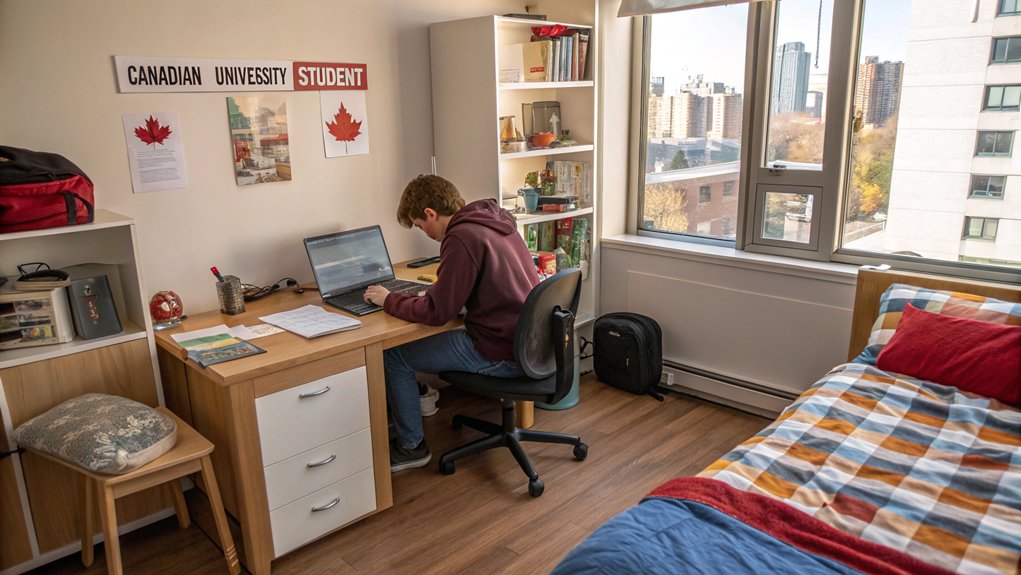Can RESP Funds Be Used to Pay Rent During Post-Secondary Education?
Most students don’t realize RESP funds can legally pay rent and housing costs during university. Your education savings work harder than you think.
RESP funds can legally cover rent payments for both off-campus housing and official residence fees during post-secondary education at recognized institutions. Students access these funds through Post-Secondary Education payments, which return original contributions tax-free, and Educational Assistance Payments, which include government grants and investment earnings taxed in the student’s hands at typically low rates. The $50,000 lifetime contribution limit per beneficiary guarantees substantial support for housing costs throughout degree programs, while flexible withdrawal options accommodate diverse living arrangements and educational timelines for thorough financial assistance.

How can families optimize their Registered Education Savings Plan (RESP) investments to cover the full spectrum of post-secondary expenses beyond tuition fees? The Canadian government’s RESP framework permits funds to be used for various educational costs, including rent and residence fees, making these savings accounts flexible tools for supporting students’ extensive living expenses during their post-secondary journey.
RESP funds can legally cover rent payments, whether for off-campus housing or official residence fees, alongside other essential expenses such as dorm meal plans, textbooks, school supplies, required tools, and transportation costs. Technology devices and student activity fees also qualify as eligible expenses, provided the educational institution maintains recognition by the Canadian government and the program meets minimum duration requirements of thirteen weeks for most courses or three weeks for university programs.
RESP funds legally cover rent, meal plans, textbooks, supplies, tools, transportation, technology devices, and student activity fees at recognized institutions.
Understanding withdrawal types becomes pivotal for maximizing tax efficiency, as families can access three distinct categories of RESP funds. Post-Secondary Education Payments (PSE) return original contributions tax-free to subscribers, typically parents or guardians, while Educational Assistance Payments (EAP) include government grants and investment earnings that are taxed in the student’s hands, usually resulting in minimal or zero tax liability due to students’ generally low income levels. The Canada Education Savings Grant provides families with up to $7,200 in additional funding to support their child’s educational goals.
Strategic withdrawal timing affects both tax ramifications and fund accessibility, with EAP withdrawals limited to eight thousand dollars during the first thirteen weeks of full-time enrollment, or four thousand dollars for part-time students. After this initial period, unlimited EAP withdrawals become available, allowing families to cover ongoing rent and living expenses without restriction. Withdrawals are taxed in the hands of the beneficiary, who will likely pay little or no tax.
Families should coordinate contributions carefully to avoid exceeding the fifty-thousand-dollar lifetime limit per beneficiary, which triggers a one percent monthly penalty tax on excess amounts. Multiple contributors, including parents, relatives, and friends, must communicate to prevent over-contribution while maximizing government grants and tax advantages. Unlike RRSPs which cannot be used directly as collateral for borrowing, RESP funds provide immediate access for educational expenses without requiring repayment schedules to the registered plan.
Documentation of expenses remains advisable to confirm eligible withdrawals, and early planning with enrollment proof expedites processing. This meticulous approach ensures RESP funds effectively support students’ broader cost of living, transforming educational savings into practical financial support for rent and essential living expenses throughout their post-secondary education.
Frequently Asked Questions
What Happens if My Child Drops Out of School Mid-Semester?
When a child drops out mid-semester, Educational Assistance Payment (EAP) withdrawals immediately cease since active enrollment verification becomes impossible, while original contributions remain accessible like Post-Secondary Education (PSE) payments.
Unused investment earnings and government grants convert to Accumulated Income Payments (AIPs), triggering the subscriber’s marginal tax rate plus a 20% penalty, though re-enrollment or beneficiary transfers may preserve benefits strategically.
Can RESP Funds Cover Rent for Off-Campus Housing?
RESP funds can indeed cover off-campus rent payments during post-secondary education. Both Educational Assistance Payments, which include grants and investment earnings, and Post-Secondary Education Payments, representing original contributions, may be used for housing expenses without specific restrictions.
Students simply need proof of enrollment at qualifying institutions, with no itemized expense reporting required for rent-specific disbursements.
Are There Tax Implications for Using RESP Money for Rent?
Using RESP funds for rent creates minimal tax consequences for most students, as Educational Assistance Payments (EAPs) containing earnings and grants become taxable income to the beneficiary, not contributors. However, most students pay little or no tax due to low income levels and available tuition tax credits, while principal withdrawals remain completely tax-free since contributions were made with after-tax dollars.
What Documentation Is Required to Withdraw RESP Funds for Housing?
RESP withdrawals for housing expenses require proof of enrollment from the registrar exhibiting student name, institution letterhead, program details, and current term dates, plus a completed withdrawal form signed by the subscriber.
Educational Assistance Payments accessing grants and earnings need enrollment verification in qualifying programs, while Post-Secondary Education Payments necessitate only basic enrollment proof and authorization to access contribution portions.
Can RESP Funds Pay Rent if Studying Part-Time?
RESP funds can pay rent for part-time students, though Educational Assistance Payment withdrawals face a $4,000 limit during the initial 13 weeks of enrollment.
Following this period, students can access unlimited EAP amounts for housing expenses.
Post-Secondary Education Payment withdrawals, representing original contributions, remain tax-free and unrestricted regardless of enrollment status, providing flexible rent payment options throughout part-time studies.
What’s next?
The information provided is based on current laws, regulations and other rules applicable to Canadian residents. It is accurate to the best of our knowledge as of the date of publication. Rules and their interpretation may change, affecting the accuracy of the information. The information provided is general in nature, and should not be relied upon as a substitute for advice in any specific situation. For specific situations, advice should be obtained from the appropriate legal, accounting, tax or other professional advisors. Full details of coverage, including limitations and exclusions that apply, are set out in the certificate of insurance provided on enrollment.
This article is meant to provide general information only. It’s not professional medical advice, or a substitute for that advice.
Saphira Financial Group does not provide legal, accounting, taxation, or other professional advice. Please seek advice from a qualified professional, including a thorough examination of your specific legal, accounting and tax situation.







